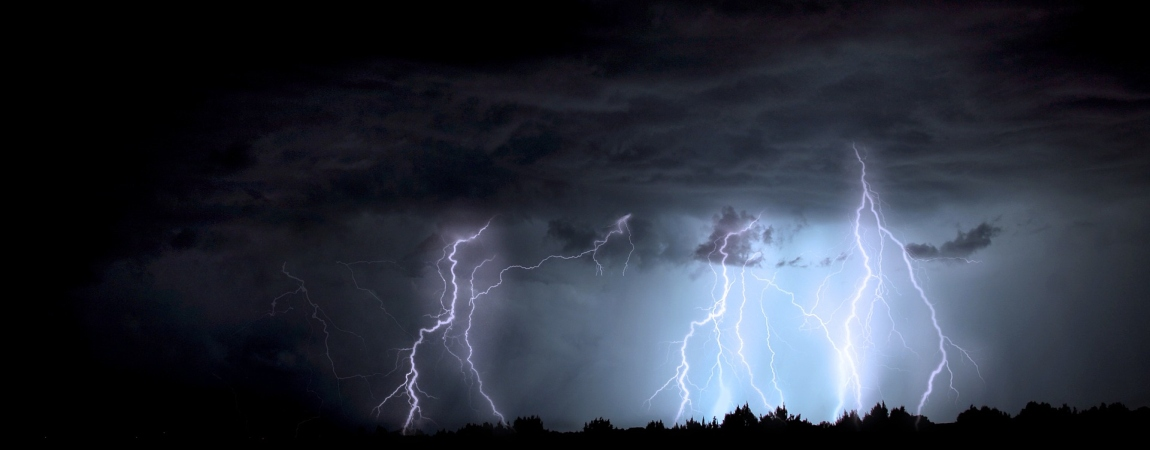Lightning is a visible electrical discharge produced by thunderstorms. Some of the most spectacular, violent and equally dangerous shows of nature’s might is produced in the form of lightning during a thunderstorm.
During this natural phenomenon, electrostatic discharge occurs between two electrically charged regions in the atmosphere or ground producing massive amounts of energy, which gets dissipated in the form of heat and light. A single stroke of lightning can contain up to 1 billion volts of electricity. This tremendous energy traveling at close to the speed of light can heat up the air to about 28,000 degree Celsius, which causes the explosion that we know as thunder.
A thundercloud or Cumulonimbus – named from Latin cumulus, meaning heaped and nimbus, meaning rainstorm – is a dense, vertical towering cloud, which can be quiet massive in size. They carry an incredible amount of water and can pack tremendous amounts of energy.
The thunderclouds form when hot, moist air rising from the ground hits the cold air high above and condenses. When more and more warm, humid air join the cloud, they become dense with water droplets. The water droplets and ice within these clouds collide with each other creating electricity. When the electricity grows it escapes from the cloud in the form of lightning.
Places frequently hit by lightning
Let’s take a look at six geographic spots on our planet where lightning occurs most frequently.
1. Lake Maracaibo, Venezuela
Lake Maracaibo, a large tidal estuary in Venezuela, receives about 233 annual lightning bolts per square kilometer, which makes it the most lightning prone place on our planet. A phenomenon known as The everlasting storm or Catatumbo lightning associated with this location results in 260 days of thunderstorm per year.
Several rivers drain into this lake with River Catatumbo being the largest. The area where this river joins the lake is the most prone area for lightning due to the humidity in the air and the height and curved nature of the geographic location. The cold air from the Andes meets with the warm air from the lake producing everlasting lightning strikes. The phenomenon reaches its peak during the wet season which comes around October every year.
2. Kabare, Democratic Republic of the Congo
Kabare was the world’s thunderstorm capital until Lake Maracaibo replaced it after renewed researches. This area on the western shores of the Lake Kivu, in the eastern part of Democratic Republic of the Congo receives about 205 annual lightning bolts per square kilometer.
3. Kampene, Democratic Republic of the Congo
Kampene, which is also located near Lake Kivu in Democratic Republic of the Congo receives about 177 annual lightning bolts per square kilometer. It is believed that the intense solar heat in the area causes massive air currents, and when they mix with the moisture from the lake contribute to the extraordinary lightning activity.
4. Cáceres, Colombia
With 172 annual lightning bolts per square kilometer, Cáceres, a municipality in Bajo Cauca, Colombia is the fourth most active lightning locations on Earth. Moist winds from the Cauca River and the mountain surrounding the city contributes to this heavy lightning.
5. Sake, Democratic Republic of the Congo
Sake is a town in the Democratic Republic of the Congo in the eastern province of North Kivu. This area, which is located on the northwestern extremity of Lake Kivu receives about 143 annual lightning bolts per square kilometer.
6. Dagar, Pakistan
Dagar, a mountainous part of Pakistan near the Afghan border receives about 143 annual lightning bolts per square kilometer. It is one of the most active lightning locations in Asia.
Some intriguing lightning facts!
1. An abnormal fear of thunder and lightning is known as Astrapophobia or Astraphobia.
2. The study or science of lightning is called fulminology.
3. When lightning hits sandy soil or sand on earth’s surface, the lightning’s heat melts the silica and forms clumps of fused glassy tube like stones known as fulgurites.
4. Lightning bolts can be extremely hot! The average temperature of a lightning bolt can reach 27,700 degrees Celsius, which makes it nearly five times hotter than the surface of the sun. The temperature at the surface of the sun is about 5,505 degrees Celsius.



0 Comments